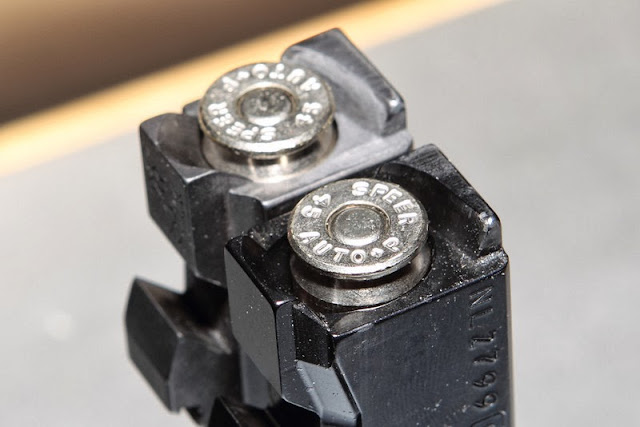In recent years much attention has been paid to the Glock .40 S&W caliber pistols as there seems to have been an extraordinary amount of KBs with these guns.
First off, kabooms are not new, they have been happening since the invention of the firearm, second, Glocks are great guns and out of the five million or so Glocks that have been sold, only a small amount have been involved in KBs. While there is no clear explanation for what is happening with the Glock pistols, many believe the unsupported area in the bottom of the chamber is partly to blame, you can see it in this picture (a G21 barrel)
Here is what the aftermath of a kaboom looks like
Another theory is that the Glock Kabooms, are caused by reloaded ammo whose cases may be been bulged or whose powder charge was too high.
It could also be the use of lead bullets, which Glock has always advised against.
Factory ammo is not infallible either, there is always the possibility that the ammo manufacturer has made a mistake.
Of course no one would admit to making such a mistake, it has to be the gun's fault right?
You have to look at this from all sides. If the Kaboom cannot be duplicated in the test lab with good ammo, what then, is the truth?
Before you go thinking that this only happens to Glocks...it could never happen to my XD
or my Smith & Wesson
Or my FN
or...
This happens to revolvers too, make sure you read the owner's manuals and use the proper ammunition!
This can even happen to Ruger Revolvers, considered by most to be the strongest of all revolvers made
The vast majority of these unfortunate accidents were caused by reloaded ammunition. One of the four following things happened:
A. The load was too "hot", either through deliberate experimentation or an accident, too much powder was dispensed into the case causing excessive pressure. The pressures could also be risen by a bullet being seated too deep.
B. Bad brass, the brass case was compromised and the re-loader either did not spot the problem or they ignored it
C. The re-loader somehow failed to put powder in one of the casings (or not enough powder). When the primer fired, it did not send the bullet out the end of the barrel. Instead it lodged it just far enough for the gun to cycle another round. When the shooter did not recognize the "squib" and fired a second shot, the build up of pressure destroyed the gun. I have seen low pressure guns (.22s mostly) with several bullets lodged in the barrel. Learn to recognize a Squib and inspect your weapon!
D. Using the wrong ammunition. Many lightweight framed guns have restrictions against the use of +P or high pressure cartridges. Read the manual and follow its instructions.
If you are a reloader and would like to avoid the possibility of a kaboom, here are some tips:
1. Check your data, read it, check it again. Dyslexia happens to all of us, make sure you read it correctly and have set the scale to the proper mark
2. Use wet stainless steel media to clean your brass casings. I KNOW it costs a lot more than the traditional methods, but your brass comes so much cleaner that it makes it easier to spot trouble areas. see my blog post here.
3. Wear glasses, even if you have perfect 20/20 vision, get a pair of "cheaters" so you can magnify your vision, this will help you find hairline cracks.
4. listen to your brass. When you dump a pile of brass casings, cracked ones will make a different noise. It is hard to describe in words, but you will know it when you hear it, investigate and find the cracked one(s).
5. Use loading trays. Perform your powder throws all at once, put all 50 cases in the tray and inspect them, by doing this you avoid forgetting one case or accidentally double charging a case. When looking them over it will be easy to spot one whose powder level looks low or high. If you find a suspect one, dump it on the scale and check it.
6. Crimp your cases. Even auto cartridges need a slight crimp. When you bell the case mouth to accept the bullet, the seating of the bullet doesn't completely remove the bell, a slight taper crimp will smooth it out. This helps eliminate feeding issues and helps keep the bullet at the desired seating depth.
7. QC, quality control! Before seating every bullet I check to make sure there is powder in the case, after seating the bullet I inspect the case again for cracks or the proper crimp. I also check the C.O.A.L. (Combined Over All Length) to make sure I have the bullet seated at the correct depth.
8. If you are working up an "experimental" load, do so with caution and in small steps, mark your altered cartridges accurately and always check for signs of high pressure (bulged cases, flattened primers etc..)
Remember safety first! These Kabooms are bad for the user, the manufacturers, our hobby and our Second Amendment Rights!


























No comments:
Post a Comment